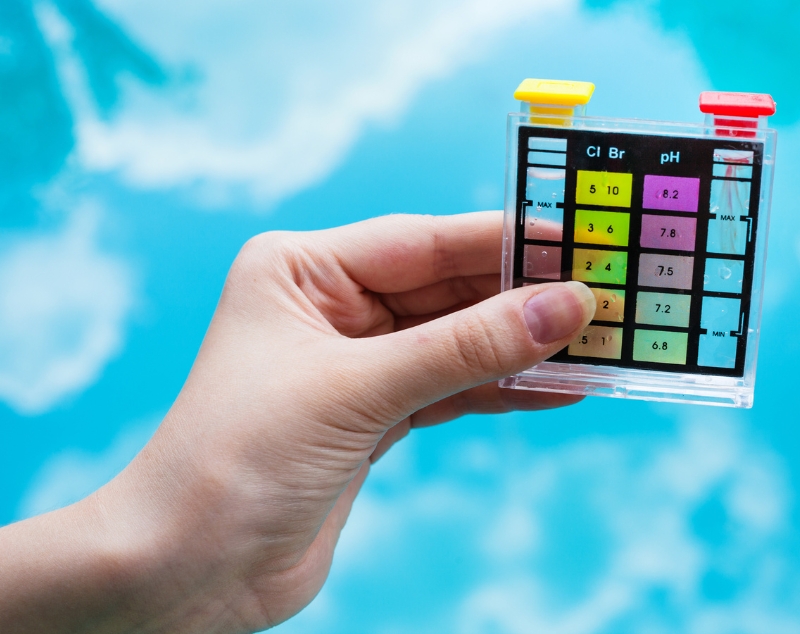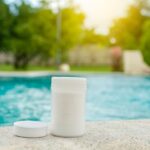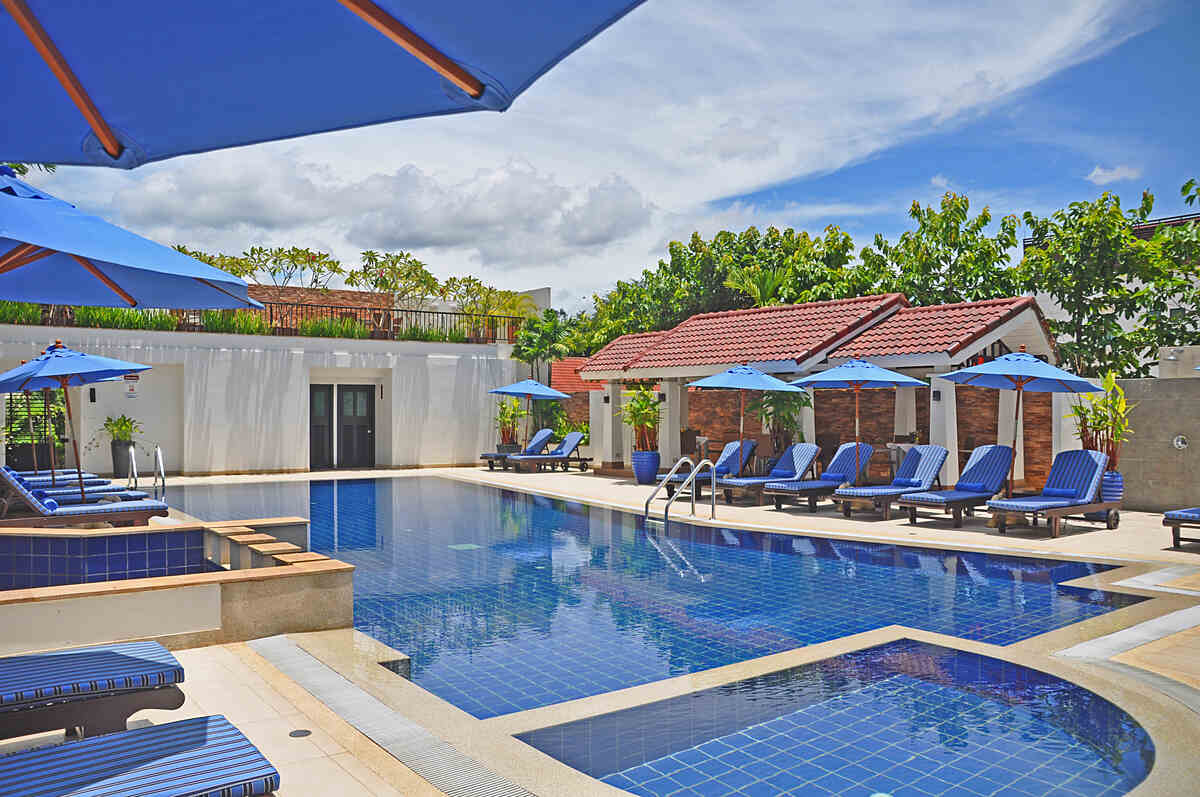
Owning a saltwater pool comes with lots of perks; softer water and no abrasive chlorine smell. Plus saltwater pools are less expensive to maintain than traditional chlorine pools. Even though saltwater pools require less attention than their chlorine counterparts, knowing how to maintain a saltwater pool will protect your investment and make pool season more enjoyable.
It takes more than skimming your pool’s top to maintain it properly. This article will cover pool sanitation, the ‘shocking truth’ about chlorine in your pool, and the unique needs of saltwater pools. Then we’ll dive into your pool’s chemistry and answer frequently asked questions about saltwater pool maintenance.
How to Keep Your Saltwater Pool Clean
A sparkling, clean pool doesn’t just happen; it requires diligence. A pool vacuum and skimmer will help get you started, but the rest is up to you. Here’s what you need to know.
Clean Built-in Skimmers
Built-in pool skimmers are located on the sides of the pool. These rectangular openings contain baskets that fill with debris, leaves, and insects as water flows in and out of the openings. These skimmer baskets need to be emptied at least once a week. Left alone, the leaves in the basket can break down and become very difficult to get out.
You can rinse the basket with a hose to dislodge any twigs or insects. Replace the basket and secure the lid.
Catch Debris With a Handheld Skimmer
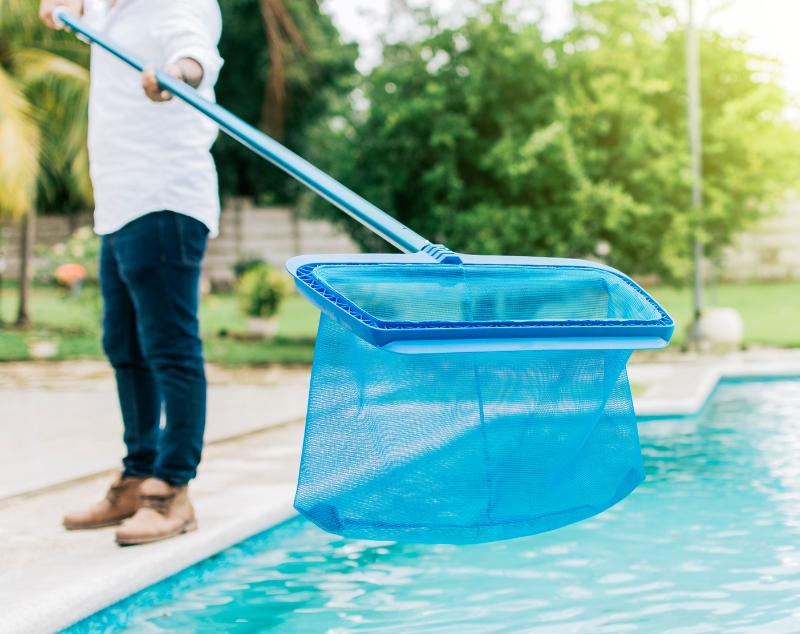
Handheld skimmers are long poles with attachable nets. You can use these skimmers as needed to remove debris and insects from your pool’s surface and lighten the workload of your built-in skimmers. A handheld skimmer can also rescue a small creature like a frog or mouse that may have fallen in when trying to get a sip of water from the pool.
Brush the Interior
A pool brush will polish your pool to perfection. These brushes can be plastic or metal and attach to the same poles as your handheld skimmers. You can protect your pool’s interior by scrubbing the bottom and sides of your pool once a week.
Benefits of brushing:
- Removes and prevents the buildup of algae
- Dislodges dirt and sand trapped in the pool’s textured surfaces
- Loosens up dirt for the vacuum and skimmers
Various brushes are available, each designed for its intended purpose and pool surface. Start with a universal brush, but choose a length that makes sense for your pool. Don’t forget to brush the steps!
Run the Pool Pump
Without a pool pump, your saltwater pool would quickly become a stagnant, algae-filled swamp. Circulation is critical for keeping your water clean and swimmable. Run your pool pump for 8 hours each day. You’ll want your pool’s water to pass through the filter at least once daily. Check your pool pump’s filtering speed against the number of gallons in your pool to ensure all the pool water is thoroughly filtered.
Note: Saltwater pools rely on generators to produce chlorine and sanitize the pool. Since the chlorine generator works in conjunction with the pump, you must run the pump to sanitize your pool.
Add a Pool Cover
A pool cover is a helpful tool for maintaining your pool year-round. Pool covers are an excellent tool for cleanliness and water level maintenance. Some pool owners cover their pools on windy days to avoid evaporation, while others rely on pool covers only during the off-season.
Pool cover pros:
- Seals dirt and debris out of the pool when not in use
- Stops water loss by evaporation
- Maintains the pool’s temperature
- Minimizes chlorine loss from the sun
Pool cover cons:
- Unsightly appearance
- Difficult to remove and replace
- Challenging to store (when not in use)
- Expensive to customize shape
Run an Automatic Pool Cleaner
Pool vacuums are a time-saving tool for sanitation. These cleaners move autonomously around your pool, clearing away sediment and debris. Run your pool vacuum for 2 to 6 hours every week. Keep in mind the speed of your vacuum and how often you swim when setting your schedule. You’ll want to allow enough time for the vacuum to clean the entire pool.
There are three kinds of automatic cleaners. Each pool cleaner has pros and cons; they work with different parts of your pool to move and pick up dirt.
Pressure pool cleaners attach to the return side port of your swimming pool. This cleaner uses pressure from your return system to move around the pool. These cleaners use your filtration system to create a strong vortex that picks up debris.
Suction pool cleaners attach to the skimmer through a suction port in the wall. It uses the pool’s pump to create suction. The pulsating water moving through the cleaner allows it to move around. Most suction cleaners cling to the pool floor with rubber disks. The powerful suction created by the pump allows these cleaners to climb walls and steps.
Robotic pool cleaners work independently from your pool pump or skimmer. These cleaners don’t have exterior debris bags; they store debris within the machine in a canister that you empty after each use.
How to Maintain the Water
A bit of work (and chemistry) goes into achieving and maintaining that clear-blue water. To start, you’ll need to understand your pool’s salt needs. Next, you’ll need to balance the pH levels while maintaining the correct water level.
Maintaining Proper pH
Maintaining your swimming pool’s pH or acidity level is critical. The ideal pH is between 7.4 and 7.6. Water below 7.4 becomes acidic and can corrode your equipment. Water above 7.6 becomes too basic, creating scale-forming conditions. Scale is a calcium carbonate that builds up on pool walls and surfaces.
Test your pool’s pH 2 to 3 times weekly with a digital water tester or a colorimetric test kit.
How to adjust your pool’s pH: If your pool’s pH is too low, add soda ash. If the pH is too high, try adding muriatic acid. If you don’t know how much muriatic acid or soda ash to add, check the test chart from the test kit. The amount needed will vary depending on your pool’s volume and current pH.
Pro Tip: Fix your pool’s pH levels before addressing its chlorine and salinity levels.
Alkalinity
Alkaline and pH levels go hand in hand. If your pH is high, your alkalinity levels will be high too. The alkalinity levels in your pool keep your pH levels from extreme fluctuations. The ideal alkalinity level is between 80 – 100 ppm (parts per million). Saltwater naturally keeps alkalinity low, so you may need to add an alkalinity increaser or baking soda to reach the optimal range. It takes about 1.5 pounds of baking soda per 10,000 gallons of water to raise the alkalinity by ten ppm.
Pro Tip: the active ingredient in alkalinity increasers is sodium bicarbonate (baking soda.) Using regular baking soda is a cost-effective way to raise alkalinity in your saltwater pool.
Sprinkle your baking soda around the pool with the pump running. You don’t need to dilute it in pool water first. Allow 6 hours for the baking soda to raise your alkalinity level.
If your alkalinity level is too high, you can use an alkalinity decreaser or muriatic acid to bring it back down. It takes about 25.6 ounces of muriatic acid per 10,000 gallons of water to lower the alkalinity by ten ppm.
Always read the instructions carefully and wear your protective gear. In most cases, you’ll dilute the muriatic acid in pool water and gently stir it before pouring it around the perimeter of your pool with the pump running. Wait at least an hour before retesting since alkalinity levels are slow to adjust. It can take 8 hours to take full effect.
Salinity
The ideal salinity (salt level) for your pool is between 3000 and 3800 ppm and should be monitored weekly. You can test the water with sodium chloride test strips or a digital water meter.
If the salinity is too high, it may corrode your equipment, and if it’s too low, it may reduce the effectiveness of your chlorinator.
To lower the salt level in your pool, add water from your hose. You may need to drain water from your pool since salt can’t evaporate. Add salt from your local pool supply shop to increase the salt level.
When adding salt to your pool,
- Turn off the salt/chlorine generator
- Turn on the pool pump
- Add the salt directly to the shallow end of your pool (avoid pouring the salt directly into the skimmer)
Allow 24 hours for the salt to dissolve fully, then turn the salt/chlorine generator back on and retest the water.
Chlorinity
Saltwater pools are easier to maintain than chlorine pools because they create their chlorine through electrolysis. In this process, electricity is sent through saltwater to interact with the chloride ions in the salt, producing chlorine. This process takes place in a chlorine generator and away from swimmers.
A salt chlorine generator can eliminate the guesswork of balancing salt and chlorine levels. These generators work by adding a small amount of sodium chloride to your pool water in an electrolytic cell which converts the chloride in the salt water into chlorine. These energy-efficient and cost-effective generators are a low-maintenance tool for sanitizing your pool. As a bonus, salt chlorine generators are also compatible with above-ground pools.
However, you should still check your chlorine levels weekly. A healthy saltwater pool also has an average free chlorine level between 1.0 and 3.0 ppm.
There are a few different ways to adjust chlorine levels in your saltwater pool:
- For minor adjustments, try adjusting the percentage settings in your saltwater chlorine generator.
- You can add salt to the pool as if it were pool shock, then brush the sides and bottom of the pool using a pool brush to protect pool surfaces from settling salt. More salt for the generator to convert into chlorine means more chlorine in your pool.
- If the water looks murky or you notice algae forming, you may switch off your saltwater generator and add chlorine until you reach the appropriate level.
- Shock your pool for a quick increase in chlorine.
Pool shock
You’d be surprised how much chlorine is in your saltwater pool. Chlorine is used as a sanitizer in all pools to kill bacteria and prevent algae growth. If you notice your water becoming cloudy or your area recently experienced heavy rainfall, you can adjust your chlorine deficit with pool shock or granular chlorine. Shock is concentrated chlorine typically used to kill bacteria after heavy use or contamination.
Test your chlorine levels to determine how much shock to add.
The best way to add shock is to dissolve the granular chlorine in a bucket of warm pool water before adding it. Mixing the shock allows it to dissolve properly, keeping it from collecting on the bottom of your pool, which causes bleaching. Plus, mixing the shock is a faster way to amend the chemical imbalance of the water.
Pour the shock mixture around the pool’s perimeter near the return jets. Ensure the pool pump is running and sweep up any chlorine granules that have settled on the bottom of your pool (shock can bleach your pool’s lining).
Shock your pool once a week and refrain from swimming in it for 24 hours after shocking to avoid skin irritation. The optimal time of day to shock your pool is in the evening since sunlight degrades chlorine.
It is a good idea to wear protective clothing and eyewear when handling pool chemicals, and do NOT pour undiluted shock into your skimmers.
Cyanuric Acid
Think of this chlorine stabilizer as sunscreen for your pool. Since the sun depletes necessary chlorine from your pool with its powerful rays, it can be challenging for your pool to maintain the chlorine it needs to sanitize itself. Cyanuric acid minimizes chlorine depletion.
Wearing gloves and goggles, mix the stabilizer in a bucket of warm pool water before pouring it into the pool.
Backwashing
Backwashing is another important part of pool maintenance. Backwashing involves reversing the flow of your pool pump. When you reverse the water flow, you clean the filter and improve the overall pump function. Backwashing dislodges any particles and debris blocking the pump. Backwashing also keeps you from cleaning the pump’s filter by hand.
Backwash when the pressure gauge rises 8 to 10 PSI (pound-force per square inch) over its starting level. This gauge is located on top of your filter. The starting PSI will vary for each pool based on the size and horsepower of your pump and your filter’s cleanliness.
To find your starting PSI: Check your pressure gauge when you install a new filter. Once you turn on your pool pump, take note of the number on your gauge (that is your baseline pressure). You can use a marker to indicate your baseline for future reference. When the gauge reads 8 to 10 PSI over your mark, your pool needs to be backwashed.
How often you’ll need to backwash will depend on your filter system, how often you use your pool, and how dirty it gets. Generally, you should backwash your pool once a week.
Maintaining the Water Level
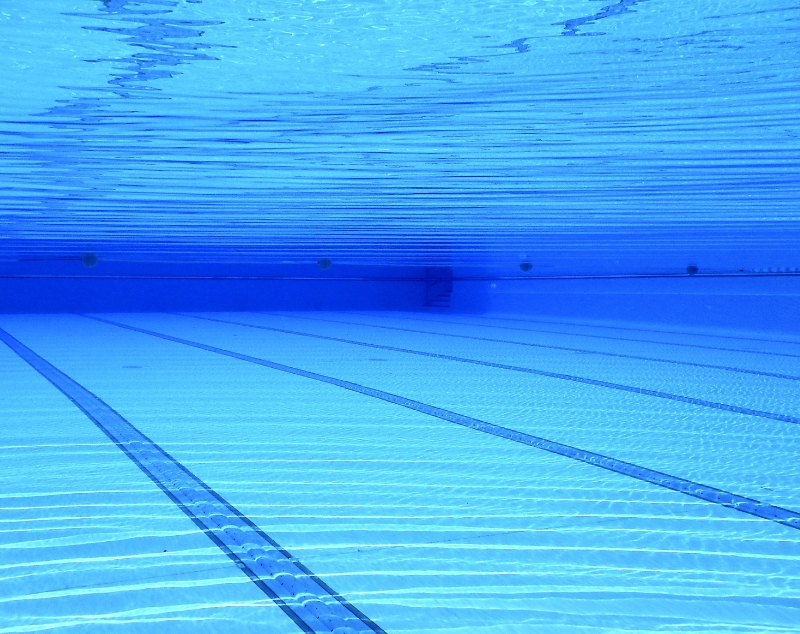
The sun not only heats your pool each day, but it also evaporates the water out of your pool inch by inch. You must monitor your pool’s water level to protect the pump.
Always keep the water level between one-third and one-half up your skimmers on the sides of the pool.
If your water level drops below this halfway marker, your pump takes in too much air, causing it to burn up. To protect your pump, keep an eye on your skimmers and add water with a hose as needed.
If your pool overflows during a rainstorm, it won’t endanger your equipment, but the prospect of an overflowing pool can be worrisome. To lower the water level, first, turn on the pool pump and vacuum, then turn your pool filter setting to ‘waste’ to drain water out of your pool.
If the water level remains high, attach the backwash hose to your filter’s waste port and drain it, (keeping the pool filter setting on ‘waste.’)
Calcium
Calcium hardness refers to dissolved calcium/lime in your pool water. Calcium hardness levels should remain between 200 and 400 ppm. Monitoring your calcium levels can protect your pool from degrading. Elevated calcium hardness levels can cause the calcium to bond with carbonates creating white flecks of calcium carbonate that can calcify and burn up your salt cell or create scale buildup. If your calcium hardness levels are too high, you’ll want to dilute or drain some of your pool water and add fresh water. Check your pool’s calcium levels once a month.
Saltwater Pool Cheat Sheet
Owning a pool requires diligent upkeep. It can be daunting to keep everything straight, so here’s a cheat sheet to help you stay on top of your saltwater pool maintenance. The tasks are broken down for you daily, weekly, and monthly to keep you on track.
Daily
- Clean the water’s surface with a skim net as needed
- Run your pool pump
Weekly
- Test your pool’s pH (2x)
- Check your pool’s chlorine levels. If your chlorine levels are off, adjust your chlorine generator.
- Check your pool’s salinity
- Run your pool vacuum
- Backwash
- Brush the sides of your pool
- Clean your pool’s skimmer and empty the skimmer baskets on the side of the pool.
Monthly tasks
- Monitor the pool’s alkalinity, salinity, calcium hardness, and stabilizer.
Annual tasks
- Inspect pool equipment
FAQ About Saltwater Pool Maintenance
Run your pool pump during the warmest hours of the day. The movement of the water helps protect the chlorine from being burnt out by the sun.
Don’t swim immediately after adding anything to your pool. Wait at least 20 minutes to an hour after adding water-balancing chemicals. Wait 2 to 4 hours after adding calcium chloride to your pool. Swimming is safe once your chlorine levels are approximately five ppm. Wait 24 hours after shocking.
Cyanuric acid and salt don’t interact, so it is safe to add them to the pool simultaneously. Amending salt and cyanuric acid together can simplify your pool maintenance routine.
On average, homeowners pay between $25,375 and $64,060 to install a saltwater pool. Don’t want to maintain your new pool yourself? Expect to spend approximately $1,430 per year for professional pool service.
Need a Professional?
Owning a pool takes work (and math). Connect with a local pro and enjoy the perks of pool ownership without the calculations.
A manicured lawn pairs perfectly with a sparkling pool; regular landscaping means less debris in your skimmers. Spend more time splashing in your pool and less time sweating behind a lawnmower with the help of a local landscaper.
Main Image Credit: Tara Angkor Hotel / Flickr / CC BY 2.0
